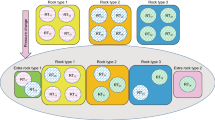Abstract
The exactness of water saturation value for given reservoir conditions depends on the accuracy of Archie parameters a, m, and n. The terms of Archie relationship have been subjected to many laboratory investigations and even more speculation. There are many factors that affect porosity exponent m, saturation exponent n, and tortuosity factor a. Usually, assumptions are made to approximate a and m; often m is 2, while a may be 0.81 or 1.0 depending on the type of lithology. But it is very difficult to fix Archie parameters regardless of reservoir characteristics; rock wettability, formation water salinity, permeability, porosity, and fluids distribution. This work illustrates a simple numerical method to calculate a and m which depends on FR-RO overlays method which is used as hydrocarbon indicator. The method is tested using synthetic and real data to ensure its ability in determining formation factor parameters a and m.




Similar content being viewed by others
Abbreviations
- F R :
-
Formation resistivity factor
- R o :
-
Resistivity of fully saturated S.S. (Ω m)
- A :
-
Tortuosity factor
- R t :
-
True resistivity (Ω m)
- S w :
-
Water saturation
- R cal :
-
Calculate resistivity (Ω m)
- R-Calc (0.52–1.6):
-
Calculated resistivity (a-m)
- ϕ:
-
Porosity
- R w :
-
Water resistivity (Ω m)
- M :
-
Cementation exponent
- R xo :
-
Flushed zone resistivity
- ϕSyn. :
-
Synthetic porosity
References
Archie GE (1942) The electrical resistivity log as an aid in determining some reservoir characteristics. Trans AIME 146:54–62
Best DL, Gardner JS, Dumanoir JL (1978) A computer-processed wellsite log computation: 19th Ann. Soc. Prof. Well Log Analysts Logging Symposium, El Paso, Paper Z
Bigelow EL, abt (1972) The “F” overlay technique and construction of the M.O.P
Carothers JE (1968) A statistical study of the formation factor relation to porosity. Log Anal 9:38–52
Fertl WH (1978) Rwa method: fast formation evaluation. Oil Gas J 76(37):73–76, Advanced Interpretation of Wireline Logs
Mabrouk WM (2005) BVW As An indicator for hydrocarbon and reservoir homogeneity. J Pet Sci Eng 49(1-2):57–62
Mabrouk WM, Soliman KS, Anas SS (2013) J Pet Sci Eng 104(2013):49–52
Porter CR, Carothers JE, (1970) Formation factor-porosity relation from well log data: Soc. Professional Well log Analysts, 11th Ann. Logging Symp., Trans., Paper D
Ransom RC (1974) The bulk volume water concept of resistivity well-log interpretation. A theory based on a new reservoir rock resistivity model. The Log Analyst, Vol. 14. No. 1
Schlumberger (1979) Log Interpretation charts, Houston, Texas
Sethi DK (1979) Some considerations about the formation resistivity factor-porosity relationships: Soc., Professional Well Log Analysts, 20th Ann. Logging Symp. Trans., Paper L
Timur A, Hempkins WB, Worthington AE (1972) Porosity and pressure dependence of formation resistivity factor for sandstones. Trans., Cdn. Well Logging Soc., 4, paper D
Winsauer WO, Shearin Jr., HM, Masson PH, Williams M, (1952) Resistivity of brine-saturated sands in relation to pore geometry, Bull. AAPG, Vol. 36 (2)
Worthington PF, (1985) The evaluation of shaly-sand concepts in reservoir evaluation. The Log Analyst, 24, No.1
Wyllie MRJ, Gregory AR (1953) Formation factors of unconsolidated porous medium: Influence of practical shale and effect of cementation: Trans. AIME
Acknowledgments
The authors would like to express their gratitude to Dr. E. M. Abdelrahman, Professor of applied Geophysics, Geophysics Dept., Faculty of Science, Cairo University for his scientific advice and comments.
Author information
Authors and Affiliations
Corresponding author
Rights and permissions
About this article
Cite this article
Mabrouk, W.M., Soliman, K.S. A numerical technique for an accurate determination of formation resistivity factor using FR-RO overlays method. Arab J Geosci 8, 1291–1297 (2015). https://doi.org/10.1007/s12517-014-1311-4
Received:
Accepted:
Published:
Issue Date:
DOI: https://doi.org/10.1007/s12517-014-1311-4




